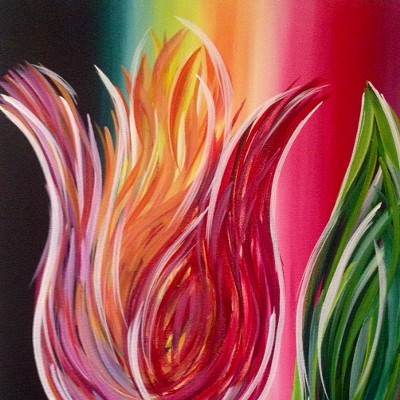The name Central Arts Collective is written on the paper over and over again in bold slashes of paint. Wild circles in blue, red and white emphasize the point that the longtime alternative gallery not only is alive and well, but is showing off its cutting-edge artists in a new exhibition called Off the Wall. The feisty show is typical Central Arts, full of youthful hubris and challenges to convention.
But rumors of the collective's demise earlier this spring were at least partly accurate, says the group's new president, Joe Rebholz, a pattern painter.
"For a couple of months, there was no Central Arts Gallery," Rebholz says. Rent had shot up to $800 a month for the group's former space at Fifth and Broadway, a tab far too high for a group that mostly attracts alternative and student artists. The gallery packed up and Etherton Gallery established a satellite branch in the space. Then former Central Arts president Moira Marti Geoffrion, an artist and UA prof, offered the displaced Central Arts a berth in her new Gocaia Gallery. Last fall Geoffrion had opened Gocaia in three large storefronts, the former Yikes/Picante space, and had room to spare.
"We got a lot of help from Moira," says Rebholz. "Without her we would have gone out of existence." The sharing arrangement helps reduce utility and operating costs for Central Arts. "We pay rent to Gocaia, and pay part of the telephone and some of the costs of the reception desk."
The collective, which usually changes membership frequently, also had to attract virtually an entire new roster of artists. Only Carl Rald remains from last year's group, Rebholz says.
The downside of the new cohabitation arrangement is that it's been hard for Central Arts to make visitors understand that it's still a separate gallery. The confusion only intensified when Central Arts' first show in its new space bore the same title--Then and Now--as a concurrent Gocaia show. For the next exhibition, Central Arts disappeared altogether, and rented its space back to Gocaia for the Native Visions show of American Indian art.
The present exhibition, Off the Wall, is meant to assert Central Arts' identity once and for all.
"We tried to think of a wild show" that would attract attention, Rehbholz explains. The 10-person show does tend toward the outrageous, though in addition to such things as a food-based installation and messages on disposable diapers there's a goodly sprinkling of more conventional painting and sculpture. For instance, Carmelita Grabowski's small bronze sculptures of bodies and body parts, set on pedestals and erupting three-dimensionally from the wall, wouldn't be out of place in a more conservative gallery. But the rule is that nothing has been permitted to cling flatly to the wall. Even Rebholz's colorful acrylics on wood panels have been set up on metal stands on the floor. They're like big, decorative sandwich boards.
R. Darden Bradshaw, the food artist, gets top honors for most off-the-wall. Her sculptural installation about bodily fat features found objects arranged in giant plastic-wrap underpants. Called Fruit OFF the Loom, the series takes aim at conventional standards of slimness. The full oeuvre at present is unavailable for inspection, as "Porker Panties" had to be removed. The pork chops used by the artist had begun to rot in the August heat.
Still remaining are "Lard Ass Undies" and "Sweet Check Bottoms." "Lard Ass" is a big squishy plastic bag loaded, not surprisingly, with lard; the whole thing has been hand-shaped to look like somebody just stepped out of the soggy pants. "Sweet Check" is a pair of giant plastic underpants stuffed with sugar: sugar cubes, Sweet 'N Low packets, light and dark brown sugar. The dark sugars, I regret to report, are congregated mostly at the bottom of the plastic underpants, doubtlessly representing solid human waste. Fruit OFF the Loom is a young work, full of chutzpah, but it doesn't have much to offer either aesthetically or emotionally.
By contrast, Shirley Oppenheimer, who travels some of the same female-body-image terrain, does use undies to convincing emotional effect. In a two-part piece called "That Was Then ... And This Is Now" Oppenheimer juxtaposes two garments that an older woman might have worn at different times of life. "Then" is one of those fox-fur stoles, complete with glass eyes and a little paw, that fashionable women used to sling round their necks. It's garishly matted in red and gaudily framed in gilt. "Now" is a sad counterpoint. It's a framed disposable diaper printed with words that are startlingly personal and yet allude to the indignities of grief that any body could undergo. "Lost my husband in March/First time alone," it reads, "I've had diarrhea for six months." This is a braver piece than the food works.
Not to be left out of the food competition is Mary Babcock, who's made a mixed-media piece of lemon slices and color photography. Two fine color photos of a nude woman discreetly covered with the lemon slices lie underneath a dangling grid of real-life lemons. More lemons, brown now, lie on the floor. The thing won't last long, no more than love sometimes does, and Babcock is using the lemons as a metaphor for sweet-and-sour love. She hasn't covered ground that Harry Belafonte did not do perhaps better in the old calypso song "Lemon Tree," but it's a charming piece nonetheless.
In another entry on women's bodies, Cynthia Stewart has produced two large photos of two frankly fat women and a fat little girl in bathing suits in "Beauty." She's dangled the pictures on clothespins on a metal frame, and draped some striped beach towels and flowered bikinis on the poles as well. The gang in her photos are unapologetically spilling out of their suits, and raising aloft beer cups in celebration. They frankly don't care that they don't look like supermodels. "Beauty" echoes the self-acceptance of Oppenheimer's deft charcoal self-portrait, "Tall Nude," which shows the artist's aging curves and soft flesh. Even Grabowski's bronzes, the "Woman with Whimsical Boobies" and the fat "Buddha Baby," pay homage to the off-kilter body.
All these works honor the self-as-is, not the self as somebody else thinks it should be. They're a fine metaphor for the rebirth of eclectic Central Arts, a gallery that sometimes hits, sometimes misses, but almost always challenges. The Tucson art scene would have been the poorer without it.
Off the Wall continues through Saturday, September 23, at Central Arts Collective, 300 E. Congress St. Gallery hours are 1 to 5 p.m. Tuesday through Saturday. For more information call 623-4588.














